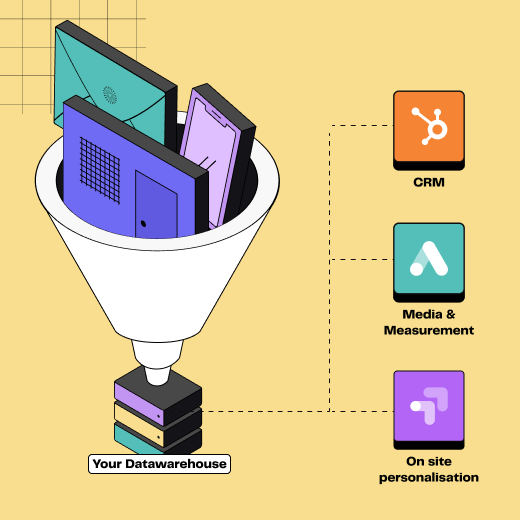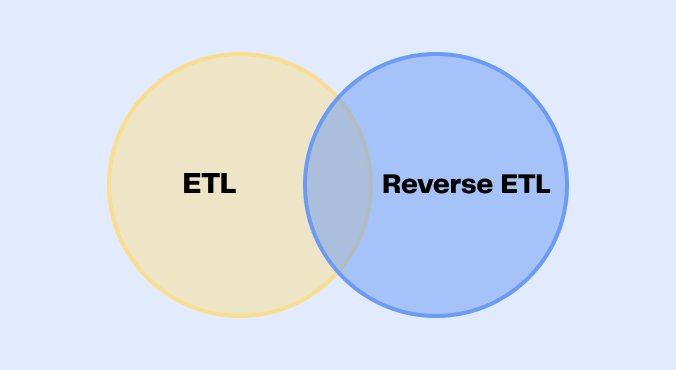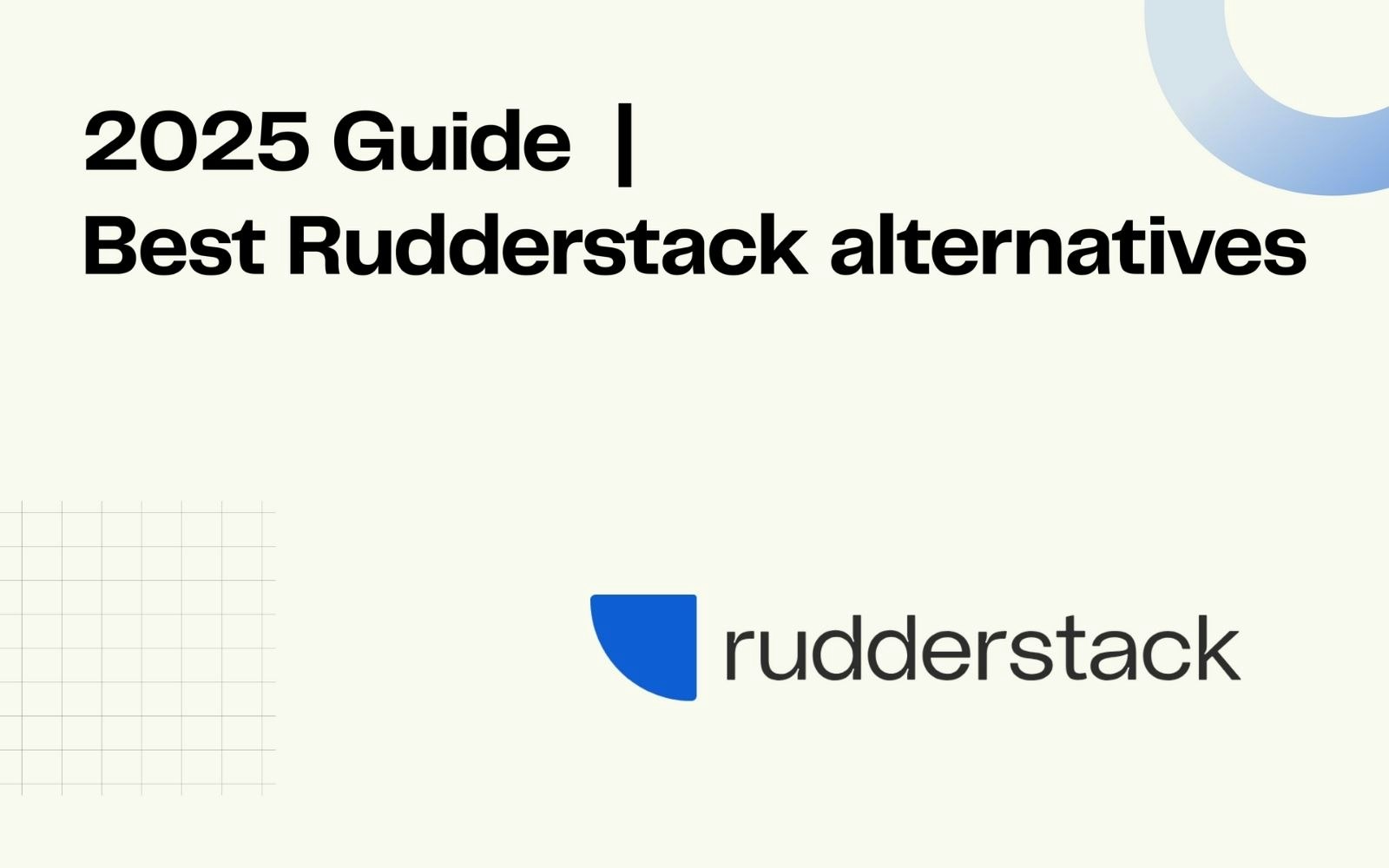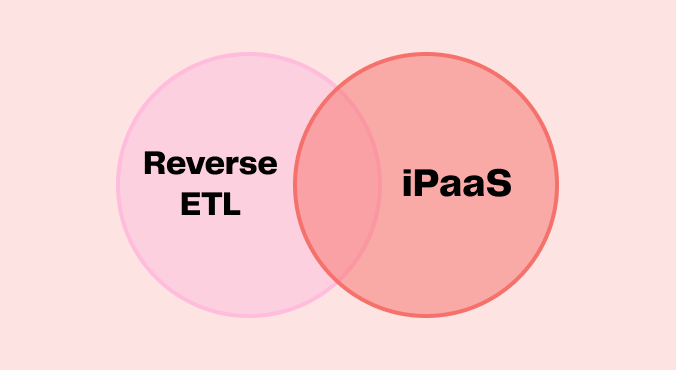
Key differences between Reverse ETL and iPaaS
4min • Last updated on Mar 12, 2025

Alexandra Augusti
Chief of Staff
Introduction
On average, companies use up to 12 different tools to interact with their customers. From websites to emails, SMS, and social media, there are ample opportunities to reach targets.
The increase in touch points has improved presence with customers but also created data silos. Information available to the CRM team may not necessarily be accessible to the media team.
Yet, in a marketing environment where omnichannel experience is essential, it is vital to break down data silos and make information accessible to all. The fluidity of information can determine a company's success.
Breaking down data silos often means creating and managing regular data flows between all the tools collecting and using this data. Unfortunately, this requires heavy data operations, and managing these movements internally is often not cost-effective. To address this challenge, various tools have been designed to enable data movement.
This article explores two main technologies in this field: Reverse ETL (Extract, Transform, Load) and iPaaS (Integration Platform as a Service).
What is Reverse ETL?
Reverse ETL is a process that involves extracting data from a data warehouse and loading it into operational systems (media platforms, CRM, support, etc.). This tool is primarily used to fuel business operations with updated data directly from the company's single source of truth.
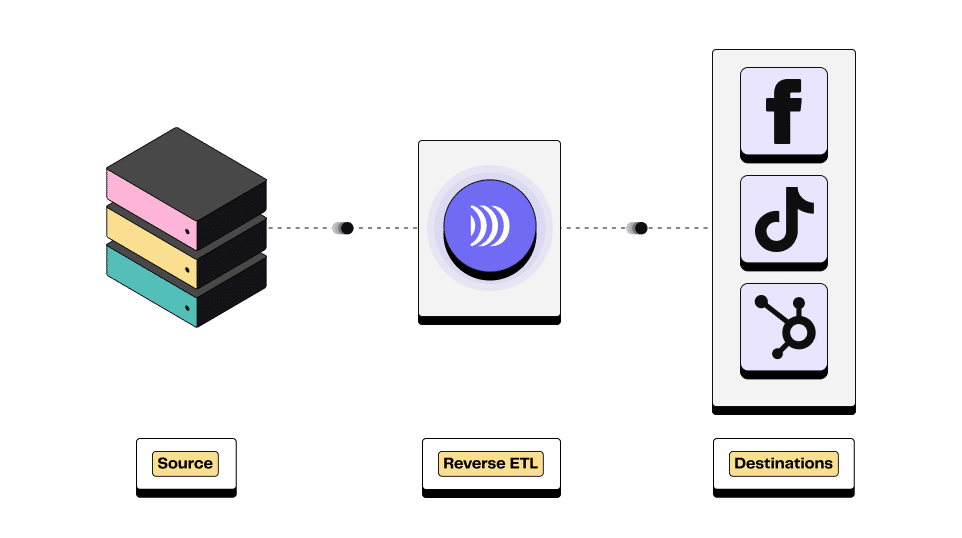
Illustration of Reverse ETL process
Reverse ETL plays a crucial role in updating operational systems with relevant data for immediate actions, facilitating quick and informed decision-making within companies.
Reverse ETL is often used for marketing use cases, to update audiences used in media platforms, send conversions, or modify attributes in the CRM. Moreover, it can also be used by finance or support teams.
What is an iPaaS?
iPaaS, or Integration Platform as a Service, is a platform that facilitates the connection and automation of processes between cloud and/or on-premise applications. This service is designed to create bridges between different systems, allowing point-to-point integration.
iPaaS stands out for its ease of use, allowing the integration of various systems bidirectionally without any coding. This ease of use is often cited as a competitive advantage of iPaaS.
iPaaS are programmed such that a specific trigger in one tool causes a specific response in another. For example, submitting a Hubspot form on the website can send a message to a specific person on Slack.
iPaaS allows creating workflows, with multiple layers and/or dependencies.
⚠️ However, workflows can quickly become complex if they involve a large number of platforms/dependencies.
Comparison of Main Features Between Reverse ETL and iPaaS
Data Integration
Both Reverse ETL and iPaaS facilitate data integration across various platforms, but in distinct ways.
Reverse ETL focuses on transferring data from a data warehouse to the end applications, using a "declarative" approach. This means you specify to your Reverse ETL the destination you want to reach (e.g., Meta Audiences), and it uses a pre-built connector to transfer your data from your data warehouse to your final platform.
iPaaS, on the other hand, allows bidirectional integration (from point A to point B) and adopts a more "imperative" approach, based on "IF/THEN" conditions. This means you must provide all the necessary instructions for your data to move from platform A to platform B: the triggering conditions, all intermediate steps, and the final destination.
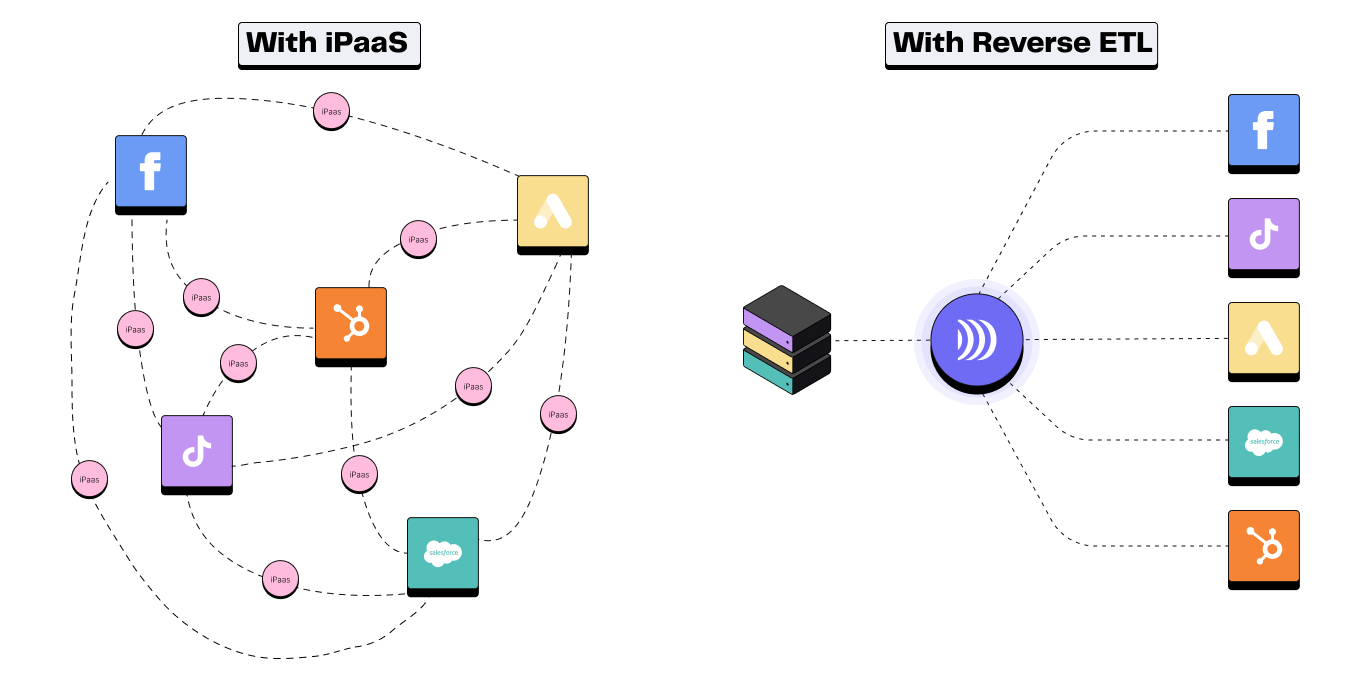
iPaaS vs. Reverse ETL
This fundamental difference highlights the specialization of Reverse ETL in handling large amounts of data, specifically with a large number of applications. The more tools to connect, the more flows to define, the more complicated it is to ensure the completeness of connections.
iPaaS, for its part, excels in managing real-time data flows between various systems: as soon as a trigger happens, the data is sent to another tool. This is why Boomi has just acquired Rivery.
Workflow Automation
While both technologies automate data transfers, iPaaS offers no-code visual interfaces that facilitate the creation of workflows.
⚠️ Reverse ETL may require a more technical understanding, although its specialized nature is valuable for specific applications. Moreover, not all types of Reverse ETL offer a no-code interface, which can complicate workflow creation for less technical teams.
Data Quality Management
Both approaches include data cleaning and validation functions. However, Reverse ETL offers superior capabilities in managing exceptions and correcting errors.
Because data is transferred in batches (and not after a specific trigger and point-by-point), Reverse ETL offers a more robust management of data pipelines. In case of mapping errors, a user can quickly identify configuration changes to make, revert to a previous state, and even resynchronize all the data that should have moved to a destination with a few clicks.
With an increase in flows on the iPaaS side, it is often more complex to understand where the error comes from. Moreover, data that should have moved but didn't due to a configuration error usually needs to be manually re-imported.
👉🏼 This ability to manage the quality of large volumes of data with precision makes Reverse ETL a preferred choice for operations requiring high reliability.
Security and Compliance
Although both platforms comply with security and regulation standards, iPaaS, due to its connective nature, may require more sustained attention to security. Managing multiple contact points can complicate security monitoring. iPaaS works like a "black box," raising governance issues.
This complexity may require more elaborate security strategies for iPaaS compared to Reverse ETL.
Scalability and Performance
Reverse ETL stands out for its architectural flexibility, efficiently managing large quantities of real-time data transactions. iPaaS, while flexible, may involve additional costs with each new integration.
This difference in cost and management makes Reverse ETL more attractive for businesses dealing with large amounts of data regularly.
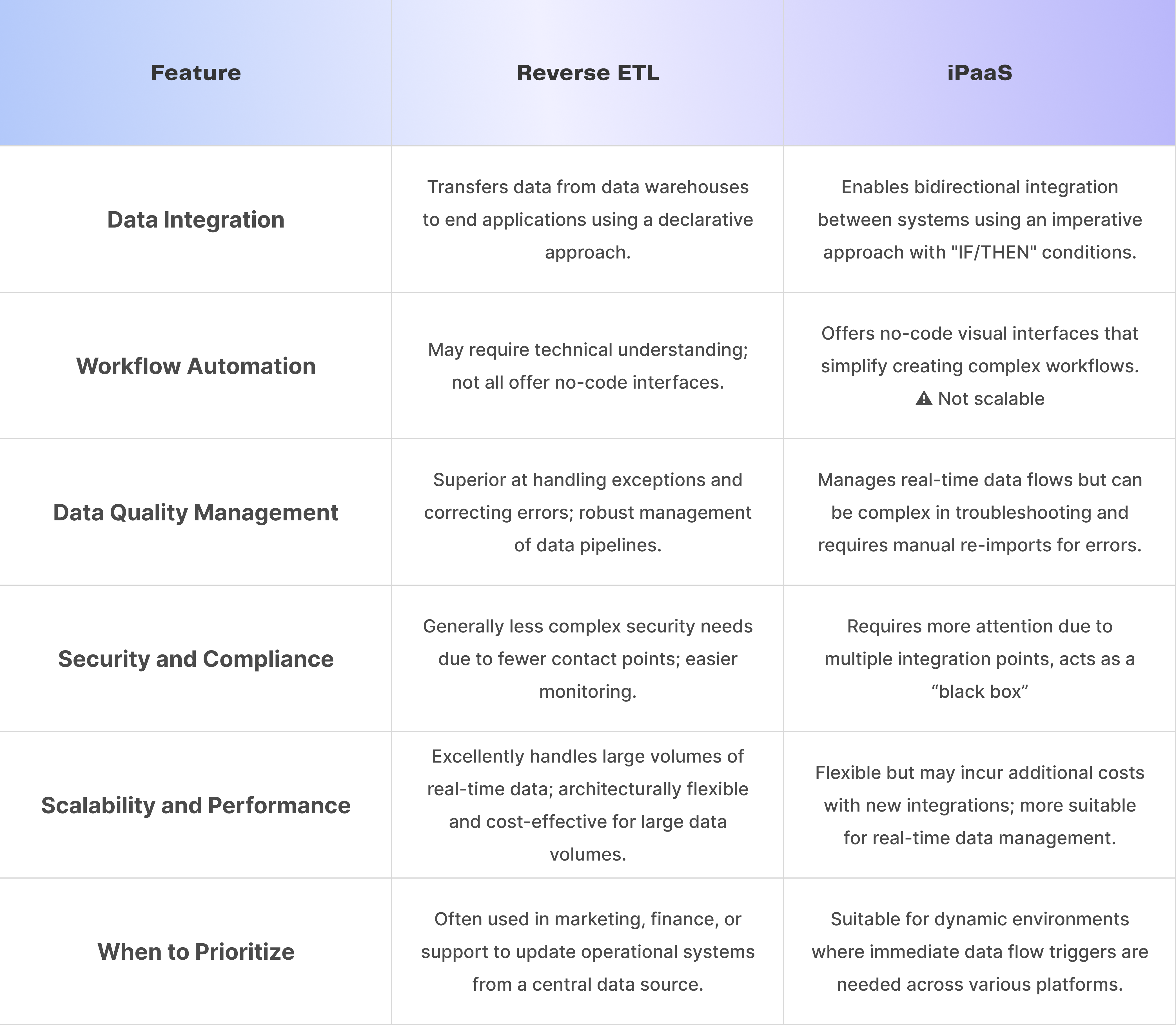
Comparison table: Reverse ETL vs. iPaaS
How to Choose Between an iPaaS and Reverse ETL?
Generally, as your IT architecture and data and marketing teams evolve, it will become increasingly expensive to rely solely on iPaaS solutions. Reverse ETL allows managing larger volumes of data, all in a centralized and more secure manner. Based on a single truth source, the data warehouse, Reverse ETL offers operational efficiency and data consistency that point-to-point solutions cannot match.
To determine if it's time for you to switch from an iPaaS to a Reverse ETL, ask yourself the right questions:
IT Architecture: What is my single truth source today? Are customer data already centralized in a data warehouse?
Data Team: How many employees work on data architecture and/or operations? Can they help me build a data warehouse? Will they be able to handle a Reverse ETL?
Marketing Stack: How many marketing tools are currently used? How is this number expected to evolve in the coming years? Can a point-to-point solution be easily set up by someone internally?
Use Cases: Have I already identified data activation use cases? How will these needs evolve in the coming months/years?
If you want to test our Reverse ETL for free, just fill out this form!
👇
Test our Reverse ETL for free
Conclusion
The choice between Reverse ETL and iPaaS strongly depends on a company's specific data integration and management needs. Companies should evaluate their data volume, transaction frequency, and security requirements to choose the most suitable tool.
Take the time to clearly define your needs before selecting the technology that will optimize your operations and support your growth. Consider scalability, security, and complexity of management before making a decision.
If you want to learn more about Reverse ETL, contact us!













